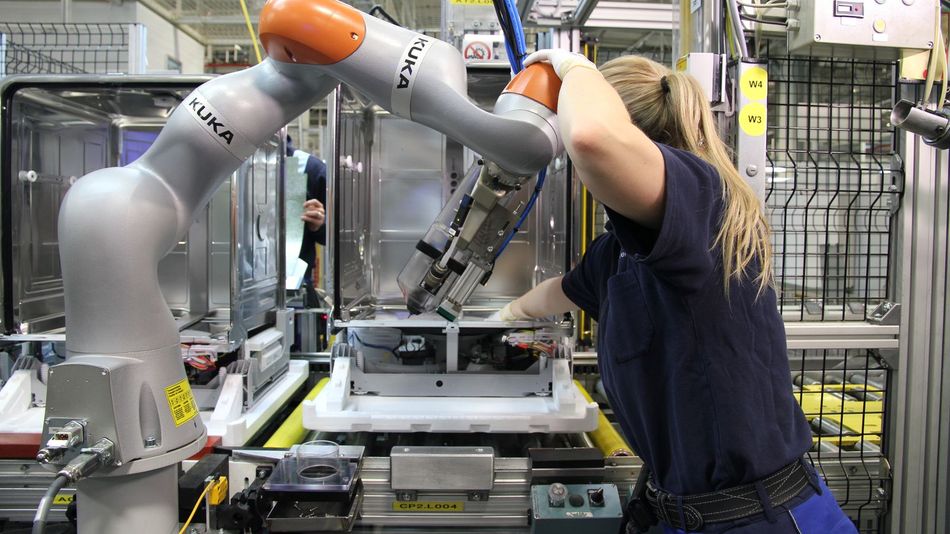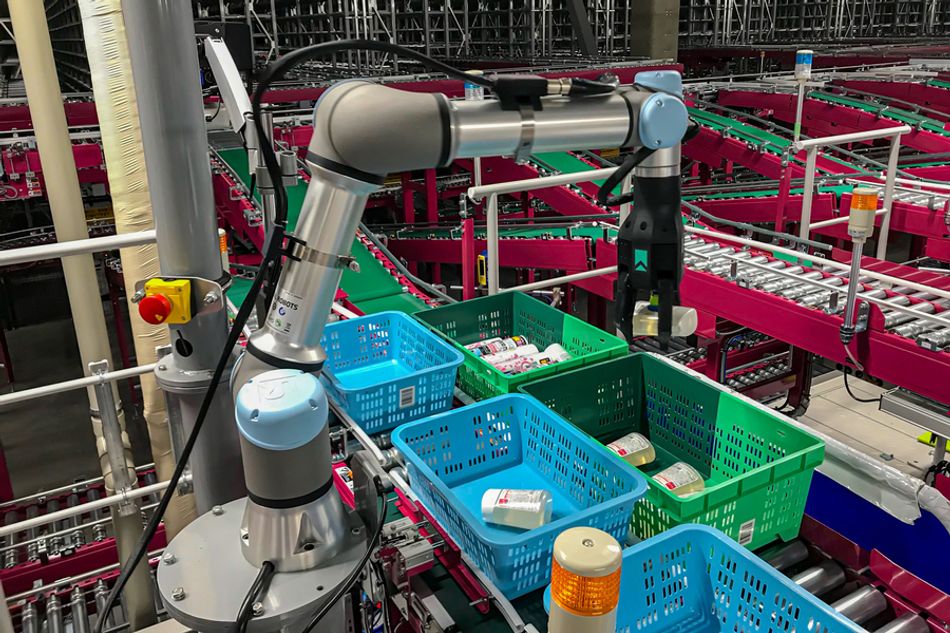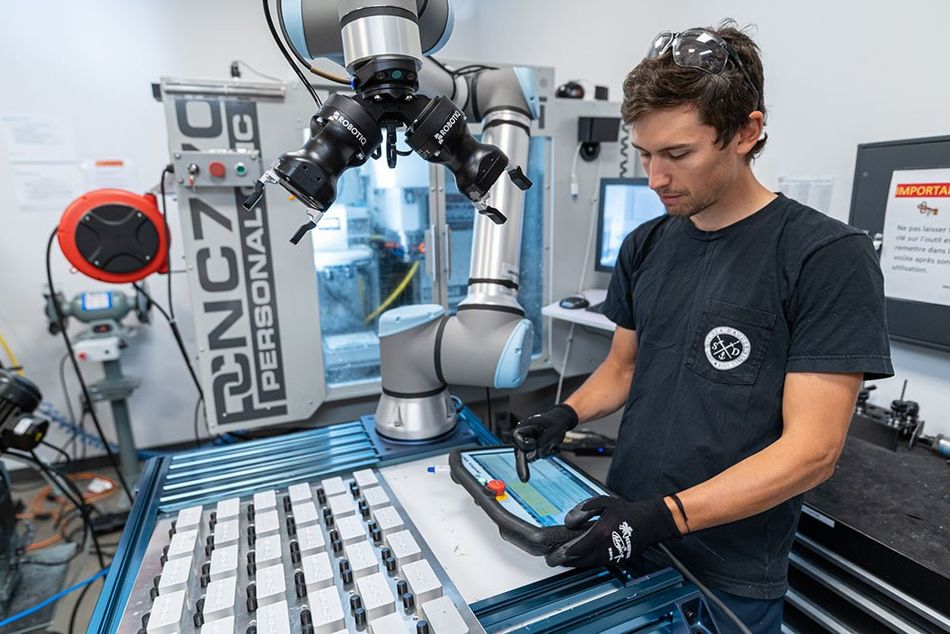Cobots and IIoT Create a Synergistic Working Relationship
Article #5 Robot Control Series. For several generations, industry has been well served by robots. The Industrial Internet of Things (IIoT) now brings collaborative robots—called cobots—into a synergistic working relationship with humans inside the future of industrial automation.

KUKA
This is the fifth article in a 7-part series examining solutions for robot control. The series looks into solutions for power, data, and signal, necessary to push the role and capabilities of industrial robots. This series is sponsored by Mouser Electronics, an online distributor of electronic components. Through their sponsorship, Mouser Electronics is dedicated to sharing knowledge about the possibility of a greener, more reliable, and better-connected manufacturing future.
IoT delivers increased coordination and control of automation
The Internet of Things (IoT) has arrived, and its future is profound. Billions of devices are being connected to the Internet, allowing for the capture, manipulation, and processing of signals from a wide range of sources. Everyday objects and devices employ sensors to capture information and are then networked for greater connection and visibility. Collecting analog data from the external world, the network encodes it into digital signals and transfers it across time and space with the Internet. Information is managed at the levels of device, edge, and cloud.
One major benefit of the IoT is the increased coordination and control of automation, which is increasingly being deployed within industry. In this setting, this subset of the IoT is known as the Industrial Internet of Things (IIoT). It is primarily concerned with the use of mostly automated and networked equipment within a system of manufacturing or other industrial production. The availability of increasingly large amounts of data brought into the network by way of the IoT-enabled devices allows for massive amounts of data to be processed quickly and efficiently, providing insight and better decision-making and process control for industry.
IIoT is converging with another key industrial technology: robotics. Robots have long been used in industrial processes. The example most people are familiar with are robotics used on manufacturing lines, such as those for automobile assembly. Semiconductor manufacturing also makes excellent use of robots for steady and reliable process control and the handling of sensitive products that require great care and consistency.
The growth of IIoT is enabling the rise of industrial cobots. Cobots are collaborative robots that have been adapted to work synergistically with humans. The use of cobots is increasing because the IIoT allows for robots to be coordinated with human activity, achieving higher levels of cooperation and efficiency. Whereas traditional robots are programmed to work mostly independent of human-specific interactive activities, cobots engage with people. They work with them cooperatively and synergistically.
This is not a cobot invasion—the taking over of an industry by intrusive force. Instead, it is an engagement, a mutually beneficial arrangement and relationship, which provides benefits for both human workers and industry as a whole. This article will look at the enabling technologies of this change, as well as some applications of cobots in an industrial setting.

Enabling Technologies
Cobots are engaging with IIoT because technology is allowing the robots to be transformed by acquiring new skills that were previously outside the domain of traditional robots. These technologies serve to enhance human and robotic interaction, improve worker safety, and reduce costs. Improvements in sensor, actuator, control, and computation technologies empower the cobot’s perception, data fusion and processing, artificial intelligence, and actuation. Other technologies promote ease of use, adaptability, and lower costs. Let’s look at three specific enabling technologies that are giving rise to cobots engaging in IIoT: artificial intelligence and machine learning, computer/machine vision, and intelligent edge computing.
Artificial Intelligence and Machine Learning
Artificial intelligence (AI) is a technique to process digital data in a manner that seeks to emulate the function, behavior, or results of human thinking. Machine learning (ML) is a subset of AI that uses algorithms that automatically improve through experience and the use of data.
Traditional robots operate according to preprogrammed instructions that get repeated without regard to changes in its operational environment. A cobot, on the other hand, incorporates AI. Cobots can to some extent perceive their environment; reason and solve problems; recognize, learn, and adapt to new situations and contexts; autonomously make decisions; and interact with humans. The “programming” of a cobot to operate in a new environment is not necessarily complicated and can involve a human operator manually walking through the desired motion by moving the cobot’s arms through the desired trajectory.
AI and machine learning is enabled through high-speed computer processors and software that may incorporate a variety of technologies such as fuzzy logic, probabilistic methods, neural networks, and expert systems. These technologies provide cobots with human-like qualities that promote human-robot interaction and collaboration.
Cobots take and process large amounts of raw data from numerous sensors. This data is integrated, processed, and interpreted, enabling the cobot to make informed and accurate deductions about the environment so that appropriate actions may get taken. This must be accomplished in virtually real-time to avoid latency issues in the cobot’s operation with humans. Machine learning algorithms effectively integrate all the data from various types of sensors, which may come from different locations within the workspace or may be sensed at different times to make informed and accurate deductions about the environment and situation. AI and ML enable the cobot to have a form of cognition that mimics human behavior, thereby allowing them to more successfully engage with humans in IIoT environments.
Computer/Machine Vision
Vision is one of the most significant human senses, and is typically the primary way in which humans perceive the external world. Similarly, cobots can be made to perceive through a process called computer or machine vision. Machine vision allows the cobot, in a manner mimicking human eyesight, to detect and identify objects, spaces, scenes, orientations, and locations in the visible (30nm–730nm), infrared (>730nm), and ultraviolet (<430nm) wavelengths. Light detection and ranging (Lidar) is a detection system that works on the principle of radar but uses light from a laser. Much of the focus on machine vision is related to working out the problems associated with adequately distinguishing and correctly categorizing objects, so that decision making and object handling do not become industrial process bottlenecks. Machine vision allows for improved accuracy, higher throughput, collision avoidance, and situational awareness.

Intelligent Edge Computing
Cobots themselves are built from edge devices, which are interconnected together within the IoT. These edge devices are continually increasing in technical capabilities and intelligence. They are becoming smarter, with the ability to sense and respond to more things and communicate and process it accordingly.
Cobots represent the next step of autonomy for robotics, giving them more ability to operate and decide how to perform their particular tasks within their work environment, even as they work alongside and in contact with humans. Increasing the complex interaction of machines and humans requires a way of handling and coordinating the vast amounts of data closest to the location of operation. The preference is for intelligent processing of the data to be done locally rather than remotely or at a hub or gateway.
The intelligent edge consists of network systems and technologies created and adjusted to meet the needs of localized data management. It must have sufficient data capacity, proper system performance, system bandwidth, security, and reliability. Further development of edge computing will allow the creation of new generations of cobots with increasingly autonomous capabilities.
Cobot Applications
New applications for collaborative robotics within manufacturing continue to develop and expand. Reliable cobots provide a safe and secure way to assist manufacturers in producing higher quality and highly adaptable processes with productivity gains. Some of the IIoT applications include assembly and manipulation, handling and loading, and inspection.
Assembly & Manipulation
Production machines such as the kind used for computer numerical control (CNC) machining must continuously be tended by an operator. This operator is responsible for loading raw material, starting the machine, ensuring its proper operation, and unloading finished parts. Assembly and manipulation tasks such as this are some of the most common industrial jobs. Often monotonous and boring, they usually do not require a high skill level, and operators are prone to injury due to repetitively lifting heavy materials and parts. Other examples of assembly and manipulation operations include stamping, grinding, trimming, welding, injection molding, printed circuit board (PCB) testing, part inspecting, and coordinate measuring.
Cobots may be an ideal fit for assembly and manipulation applications. They can be placed in front of a traditional manufacturing machine and are easily programmed to perform the required loading and unloading tasks. Periodically, skilled technicians may examine the machine and tools and perform regular maintenance. This can lead to better workforce utilization, where the cobots get used for the lower-skill-level manual operations, and technicians get used for the higher-skill-level tasks such as inspecting, repairing and changing tools, performing quality control tests, and taking appropriate corrective actions. This, in turn, can result in significant labor savings, lower injury rates, less production downtime, a more highly motivated workforce, and higher productivity.

Pick and place robots require the precise location of the unfinished assemblies and parts. Cobots are adaptable to non-precise placement, as they incorporate machine vision systems that facilitate positional feedback. A collaborative or adaptive assembly operation may involve the use of a human operator first to inspect, sort, and select a particular part, then roughly align the part onto an unfinished assembly (that is, a work-in-progress). In a subsequent assembly step, a cobot would complete the construction by fastening the part to the incomplete assembly. An operation such as this might be advantageous in situations where pieces are too small to align with unaided human vision; or where the final alignment and attachment of the part requires a great deal of dexterity or strength; or where final assembly must get performed at high temperatures, in a challenging environment, or with hazardous chemicals or adhesives. A cobot is useful in any situation where the location, orientation, or placement of parts onto an unfinished assembly is not accurate or repeatable.
Handling and Loading
Handling and loading tasks may involve the removal of products from an assembly line or conveyor belt, counting and wrapping them appropriately, applying labels, placing them into cartons, and sealing the cartons. High-speed, high-volume manufacturers can create specialized robotic machines and equipment for packaging. Cobots may be an ideal fit for such handling and loading applications.
Collaborative robots can be used to augment human capabilities during manufacturing and assembly operations by assisting in the performance of repetitive tasks or tasks that require strength or extended reach. Manufacturing operations often may require lifting and positioning a substantial part, like an automobile door, onto an unfinished assembly, like an automobile body. Such a process might not lend itself to a completely automated operation if it requires fine adjustments to the part’s position to ensure the part properly fits onto the unfinished assembly. In an automobile assembly operation, different vehicle styles might require varying numbers and forms of doors for installation, which may not be a suitable situation for a completely automated process. However, a cobot may be useful in this situation to lift the massive part. It could then carry out “instructions” from the human operator by responding to the operator’s touch and then move to position the piece on the desired location of the unfinished assembly.
Inspection
Cobots can provide careful examination or scrutiny of items and never get tired, bored, or distracted. This makes them significant assets to improve IIoT processes related to safety, quality, and productivity. Cobots may be easily programmed to recognize and count items on a conveyor belt, apply packaging materials and labels, and place them into the appropriate cartons. Human workers may still work with the cobots while performing higher-skill-level tasks such as oversight related quality-control inspections. Programming for the cobot may get easily modified to adapt to changes in the product configuration or packaging requirements.
Conclusion
Cobots are already working alongside humans and becoming increasingly engaged in the world of IIoT. The IIoT is fostering new relationships between man and technology that are enabling digital and robotic technologies to improve performance and satisfy human needs. The future of industrial automation is not robots invading the workplace, but rather engaging with the workplace to make it better.
This article was initially published by Mouser and TE in an e-magazine. It has been substantially edited by the Wevolver team and robotics writer Dillon Garrison. It's the fifth article of a 7-part series exploring solutions for robot control. Future articles provide an overview of servo motor connections, discuss the role of digital twins in robot connectivity and look at trends in manufacturing automation.
Article one looked at gains made by improved connectivity in industrial settings.
Article two looked at the quality of connectors for harsh environments.
Article three provided an overview of common motor types.
Article four listed 6 Connectivity Solutions For Industrial Robotic Applications.
Article five explores cobots and connectivity.
About the sponsor: Mouser Electronics
Mouser Electronics is a worldwide leading authorized distributor of semiconductors and electronic components for over 1,100 manufacturer brands. They specialize in the rapid introduction of new products and technologies for design engineers and buyers. Their extensive product offering includes semiconductors, interconnects, passives, and electromechanical components.

